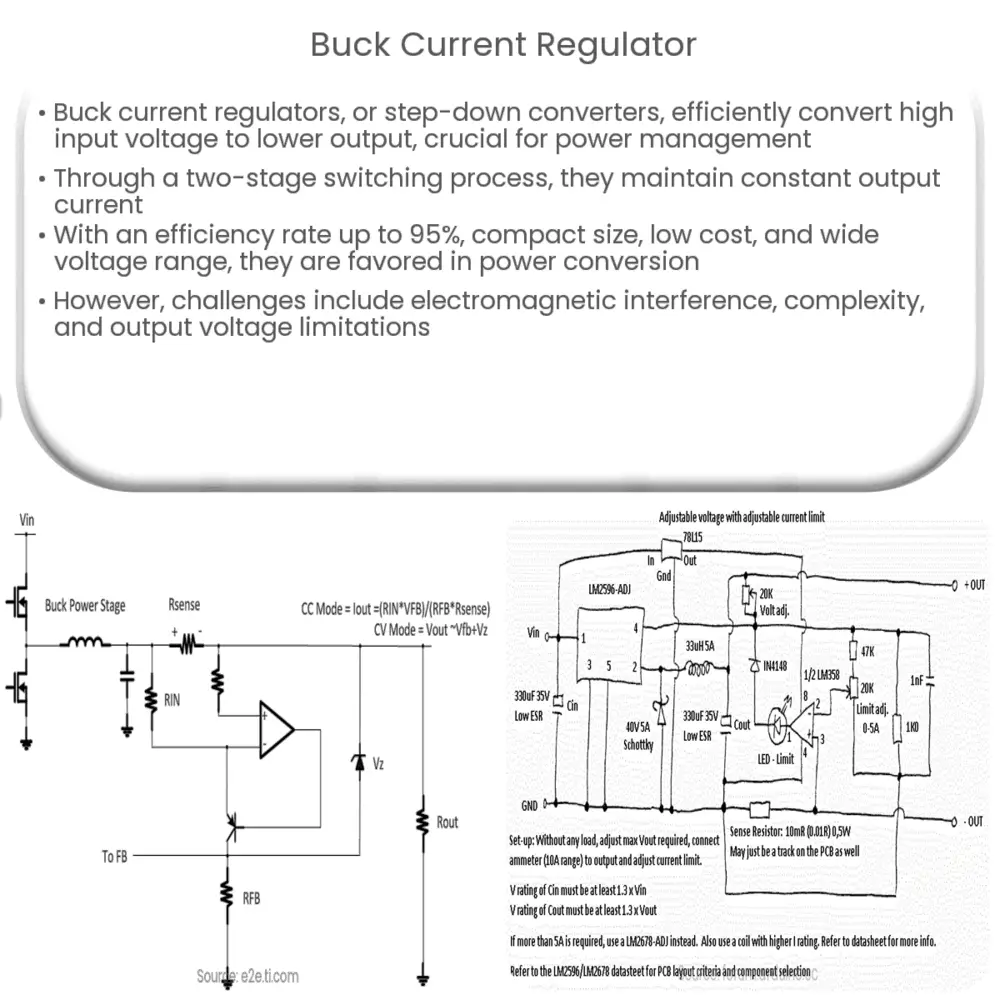A buck current regulator is an efficient power converter that steps down input voltage while maintaining constant output current for various applications.

Buck Current Regulator: An Efficient Solution for Power Conversion
Introduction
A buck current regulator, also known as a step-down or buck converter, is an essential component in power electronics that efficiently converts a higher input voltage to a lower output voltage while maintaining a constant output current. The primary function of a buck current regulator is to manage power consumption and provide a stable voltage to sensitive devices, ensuring their proper operation and increasing their overall lifespan.
How Buck Current Regulators Work
A buck current regulator operates using a switching mode to regulate output voltage. The basic components of a buck converter include an input source, an inductor, a diode, a capacitor, and a switch, typically in the form of a transistor. The switch controls the energy transfer from the input source to the output, allowing the converter to maintain a constant output current while reducing the input voltage. This process occurs in two distinct stages:
- On-state: When the switch is closed, current flows through the inductor, storing energy in its magnetic field. The diode is reverse-biased, preventing the flow of current through it.
- Off-state: When the switch is opened, the energy stored in the inductor’s magnetic field is released, providing the output voltage. The diode becomes forward-biased, allowing the current to flow through it and maintain the output current.
By rapidly switching between the on-state and off-state, a buck current regulator can effectively control the output voltage while maintaining a constant output current.
Advantages of Buck Current Regulators
There are several advantages to using a buck current regulator in power conversion applications:
- Efficiency: Due to its switching operation, a buck current regulator has a high efficiency rate, often reaching up to 95%. This makes it ideal for applications where power consumption is a concern, such as in battery-powered devices or renewable energy systems.
- Size: Buck converters are typically smaller and lighter than other types of voltage regulators, such as linear regulators, making them suitable for compact designs.
- Cost: The components used in a buck converter, such as inductors and capacitors, are relatively inexpensive, reducing the overall cost of the converter.
- Wide input voltage range: Buck converters can handle a wide range of input voltages, providing a versatile solution for various applications.
Applications of Buck Current Regulators
Buck current regulators are widely used in a variety of applications, including:
- Power supplies for electronic devices, such as smartphones, laptops, and IoT devices
- Automotive systems, including electric vehicles and auxiliary power supplies
- LED lighting systems that require constant current
- Renewable energy systems, such as solar panels and wind turbines, for converting variable input voltage to a stable output voltage
Design Considerations for Buck Current Regulators
When designing a buck current regulator, several factors must be taken into account to ensure optimal performance:
- Switching frequency: The switching frequency determines the rate at which the regulator transitions between the on-state and off-state. Higher switching frequencies allow for smaller inductor and capacitor sizes, resulting in a more compact design. However, higher frequencies also lead to increased switching losses, which may reduce the overall efficiency of the regulator.
- Inductor selection: The inductor plays a crucial role in storing and releasing energy during the switching process. Choosing the right inductor value is essential for achieving the desired output voltage and current levels. Additionally, the inductor’s saturation current rating must be considered to prevent the inductor from reaching saturation and causing performance issues.
- Capacitor selection: The output capacitor is responsible for smoothing the output voltage and maintaining a stable output current. Selecting the appropriate capacitor value and type is crucial for minimizing output voltage ripple and ensuring stable performance.
- Thermal management: Proper heat dissipation is vital for maintaining the efficiency and reliability of a buck current regulator. Adequate thermal management measures, such as heat sinks or cooling fans, may be necessary to prevent overheating and ensure the longevity of the converter.
Challenges and Limitations of Buck Current Regulators
While buck current regulators offer numerous benefits, there are some challenges and limitations to consider:
- Electromagnetic interference (EMI): The rapid switching of a buck current regulator can generate EMI, which may interfere with the operation of nearby sensitive electronic components. Careful design, shielding, and filtering techniques can help mitigate EMI issues.
- Complexity: The design and implementation of a buck current regulator can be more complex than that of a linear regulator, requiring additional components and control circuitry.
- Output voltage limitations: Buck converters can only step down the input voltage, meaning they cannot generate output voltages higher than the input voltage. In cases where a higher output voltage is required, a boost or buck-boost converter may be more appropriate.
Conclusion
Buck current regulators provide an efficient and versatile solution for power conversion in a wide range of applications. By understanding the principles of operation, advantages, design considerations, and potential challenges, engineers can effectively implement buck current regulators to optimize power consumption and ensure the proper functioning of electronic devices.

